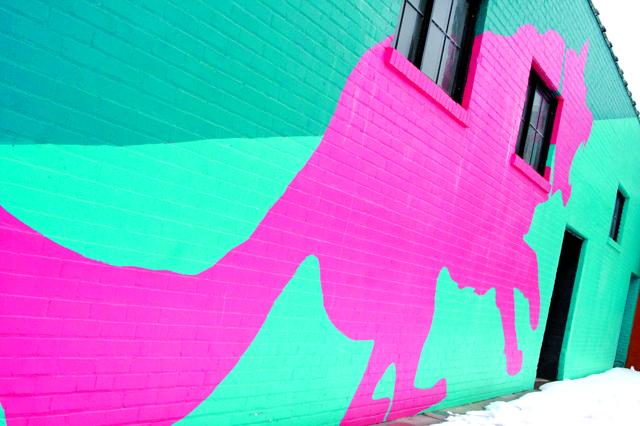- Pink dog barking, maybe a phoenix rising? The arts council is starting a new year in a new River Arts District space — with hopes for reviving a crippled organization. PHOTOS BY JONATHAN WELCH
- A work in progress: New AAAC program director Graham Hackett hopes the local arts community will engage the council.
"This is kind of a phoenix act that we're pulling off," says Graham Hackett, program director for the Asheville Area Arts Council. He's talking about the opening of The ARTERY, a 1,400-square-foot multipurpose space in the River Arts District's new Pink Dog Creative studios — and with that opening, the resurrection of the local arts-promoting organization. "This is the first time the Arts Council has had a public facade since the Front Gallery closed," says Hackett.
The Front Gallery was an exhibition hall at 11 Biltmore Ave.; it's been closed for nearly two years. In fact, the local arts council dates back much further than that gallery — it was formed by the Junior League and incorporated as the Civic Arts Council in 1952. Individual artists, arts organizations and Civic Arts Council members united in 1979 to form the Community Arts Council of WNC; that name changed to The Arts Alliance in 1992 and then to Asheville Area Arts Council in 2000.
The latter served as an umbrella for five areas of programming: Arts-in-Education, Artist Support Services, Organizational Support Services, Community Services and the Urban Trail. But in 2009, the Arts Council went on a hiatus that included staff and board turnover and restructuring; the council lost its executive director and board chair, among others, in the same year. A North Carolina State Arts Council-provided consultant recommended that AAAC sell off its property to repay debts. Says Hackett (who accepted his position last year), "The common understanding was that we folded, which was very near the truth. With a new vision, new direction and new framework for how we're operating, I think we're going to come out of the gates swinging."
When the doors to the ARTERY open on Friday, here's what you'll find: A clean slate of a space defined by a sculptural, textured woodblock wall bisecting the room. A 4-foot raised platform area can be used as a stage, for meetings or additional seating. The grand opening features artwork by Kathryn Temple and music by The Working Otet. But that's just what's tangible. "Being down in the River District, we feel like it has the potential to be sort of a default visitor's center for the arts," says Hackett.
The arts council has, to some extent, Randy Shull to thank for helping with its core restructuring; He also suggested the Pink Dog space that he and his wife Hedy Fischer own. While the council was working with its consultant, a few arts-community leaders were brought in to help, including Shull. And the Pink Dog building seemed like a good fit.
“With this move, we’re getting in the more-public space where other artists are working, in the area viewed as an arts district,” says board chair Tom Hayes, who took the helm after the abrupt departure of the former board chair. “It’s a natural space for us.”
Hayes added that there will be easier access and better parking to the council’s new home than was available downtown — and “better views of the trains,” he says with a laugh.
All of that will enable the council to host more public programming than has been seen before, say Hayes and Hackett.
"We might have movement workshops, painting workshops, computer workshops. Hands-on skills development is one style of workshop; the other is professional development," says Hackett. For small-scale shows, the space will be outfitted with a sound system, lights and modular seating. And: "We're looking at making it available and affordable to both organizations and independent artists." Already, the ARTERY has been used for rehearsals by a film crew.
With the reopening of AAAC, a made-over, streamlined website will be launched. "It's completely interactive," says Hackett. "It's not just a place to get information, but a place where the community can leverage [the Arts Council’s] visibility to their benefit." That means relevant topics on the information boards and places to post jobs, auditions and calls to artists. The ARTERY's membership program, to be unveiled this month, includes the chance to submit work to juried, quarterly indoor and outdoor (the in-process sculpture garden) exhibits.
But what's to say that this leaner arts council will succeed where its predecessor failed? Hackett is candid: "Working back against the completely disintegrated arts council's reputation and lack of any infrastructure — this is entirely an experiment, there's still no guarantee of success." He and the AAAC's current advisory board have learned from past mistakes, though.
Says Adrienne Crowther, former executive director of the Arts Council, “I've seen [the Arts Council] go through several changes … from almost primarily a funding agency to its current incarnation. I think the move to the River Arts District will give Graham and his board of directors a great opportunity for a fresh start, to develop and fine-tune the mission according to the current needs of the arts community.”
"The previous mission was far too expansive — it literally said to integrate the arts into every aspect of community life," says Hackett. "How do you endeavor to do that? It led to a lot of disappointment. And there was never a strong enough vision for what an arts council was supposed to be in a town like this, because this town is very unique. The role of the arts council, in my opinion, is to serve as an advocate for the creative sector."
Hackett's vision for the new AAAC came mainly from being on the other side of the organization, as a working artist looking for support for programs like Catalyst Poetix and Variable TV. He says that "it was very confusing and mysterious, what the arts council's role was in the community, and how to relate to it as a creative working professional." When he became aware that the council and its grants program could be lost, he applied for the program director position because, "The little activist in me wanted to make that happen."
AAAC, in its previous incarnation, was redundant in its offerings, according to Hackett. "There are plenty of galleries in town, no need for us to have a gallery. Arts and education was a big thrust of the council, but there are other providers who are handling that readily," he says. "What we're doing now is stretching a canvas for teaching artists and performing artists to provide resources, so they'll be doing the programming.”
And already it's happening. The calendar includes dates for an Asheville Artist Alliance Workshop on social networking (the AAA is a collaboration between the Arts Council, Mountain Bizworks and Arts 2 People, providing professional development training); The Moog Foundation has plans for "Pushing the Envelope" (a display and show accompanied by workshops in which artists interpret what the envelope, a part of the synthesizer, does); and the March 16 and 17 State of the Arts Summit for independent artists and organizations, held at the Masonic Temple and Hilton Biltmore Park.
It's a challenge for sure, but one Hackett seems ready to face. As long as the local arts community is ready, too. “If the community values the existence of an arts council, it's important that community members get involved and support their work,” points out Crowther. “The Asheville Area Arts Council is one of the oldest arts councils in the country.”
Hackett adds, "However much the community engages with the council will determine the benefits we can provide. It's very much a work in progress."
— Alli Marshall can be reached at amarshall@mountainx.com.
what: Grand opening of the Asheville Area Arts Council
what: With fine art by Kathryn Temple, music by Ben Mason and The Working Otet
where: The ARTERY, 346 Depot St.
when: Friday, Jan. 21 (7 p.m., free. AshevilleArts.com)






Best wishes to you! Here are some suggestions: have free and very-low cost programs every month, on a regular schedule. Most art and craft courses are WAY, WAY too expensive. I want mini-courses for just a few hours or an afternoon, perhaps a sampler to try to attract people to sign up for longer sessions. Some could be offered when school children have days off. (Public libraries do some of these, but not regularly and not usually during the school year.)
Also you could give some of your awards to rising young artists in the public and charter schools and community colleges, with county-wide and Western NC contests where you’d display and publicize the winning entries, on a website and at Pack Place or the downtown library, as well as in your new building in the River Arts District. Please reach out to average citizens, not just to professional artists…